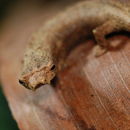Description
provided by AmphibiaWeb articles
Bolitoglossa colonnea is commonly referred to as the Ridge-headed Salamander, due to the elevated fleshy ridge between the eyes. Ridge-headed Salamanders are a medium-sized, sexually dimorphic species with a maximum SVL of 42 mm in mature males and 50 mm in mature females. Total length (including tail) can reach 130 mm (Bruce 1997; Leenders 2001). A relatively short tail and trunk, as well as short, robust limbs characterize this species (Leenders 2001). Digits and phalanges are nearly completely webbed. Hands and feet resemble fleshy pads where the digits are barely visible. Feet are sometimes a lighter color than the rest of the body. On each side of the snout a protuberance bearing a naso-labial groove is easily observable. Large pad-shaped mental glands are present under the male's chin. This species is capable of metachrosis; the body is typically a mottled dark-brown or black during the day and turns an overall salmon or tan color during the night, and is sometimes observed with small dark spots (Guyer and Donnelly 2005; Leenders 2001).This species was originally described as Oedipus colonneus in 1924 by Dunn. In 1944 Taylor renamed the species Bolitoglossa colonnea. In 2004 the species was recognized as Bolitoglossa (Eladinea) colonnea (Parra-Olea et al. 2004).A Spanish-language species account can be found at the website of Instituto Nacional de Biodiversidad (INBio) (http://darnis.inbio.ac.cr/FMPro?-DB=UBIpub.fp3&-lay=WebAll&-Format=/ubi/detail.html&-Op=bw&id=4332&-Find).
- Bruce, R. C. (1997). ''Life history attributes of the salamander Bolitoglossa colonnea.'' Journal of Herpetology, 31(4), 592-594.
- Sever, D. M. (2003). ''Courtship and mating glands.'' Reproductive Biology and Phylogeny of Urodela (Amphibia). D. M. Sever, eds., Science Publishers, Incorporated, Enfield, New Hampshire.
- Solis, F., Ibáñez, R., Savage, J., Wake, D., Chaves, G., and Bolaños, F. (2008). Bolitoglossa colonnea. In: IUCN 2008. 2008 IUCN Red List of Threatened Species. www.iucn.redlist.org. Downloaded on 19 February 2009.
Distribution and Habitat
provided by AmphibiaWeb articles
Bolitoglossa colonnea is one of the more commonly occurring salamanders in Costa Rica. Its population is concentrated on the Caribbean slopes and in southwestern Costa Rica. It has also been found in central Panama and on the Pacific slopes of the Osa Peninsula in Costa Rica near Panama. It occurs up to at least 1,000 m ASL (Guyer and Donnelly 2005; Leenders 2001).
Life History, Abundance, Activity, and Special Behaviors
provided by AmphibiaWeb articles
This species is mainly nocturnal, coming out at night to hunt for small arthropods. Sampling on both wet and dry nights in Rancho Naturalista, Costa Rica was equally successful in locating animals (Bruce 1997). Bolitoglossa colonnea can typically be found on damp leaves or in low vegetation about one meter above the ground. It can also be found on epiphytic plants, leaf litter, dead tree bark, or on the axils of bromeliad leaves (Guyer and Donnelly 2005). Males apparently produce sperm on a year-round basis, and gravid females were also found to have no seasonal variation in yolked follicles (Bruce 1997). These findings suggest that mating could occur in any month; however, Bruce (1997) did not make collections during February through April (months with considerably less rain). When males become reproductive they develop premaxillary teeth, which are used to scrape the skin of their mate during courtship (Guyer and Donnelly 2005). Doing so delivers chemicals from the male’s mental glands (located under the male's chin), which is thought to increase the female’s receptivity to mating. Members of the genus Bolitoglossa have large pad-shaped mental glands that are short and vertically oriented. The glands are positioned posterior to the mandibular symphysis (Sever 2003).Eggs are laid in clutches in moist environments (Bruce 1997; Guyer and Donnelly 2005). Direct development has been observed and the species does not seem to be dependent on water (Solís et al. 2004). There is no apparent correlation between clutch size and body size (Bruce 2007).
Life History, Abundance, Activity, and Special Behaviors
provided by AmphibiaWeb articles
Bolitoglossa colonnea is relatively abundant and is not considered threatened (Solís et al. 2004).
La Loma salamander: Brief Summary
provided by wikipedia EN
The La Loma salamander (Bolitoglossa colonnea) is a species of salamander in the family Plethodontidae. It is found in Costa Rica and western Panama. The common name refers to La Loma, its type locality on the trail between Chiriquicito and Boquete, earlier in the Bocas del Toro Province but at present in the Ngäbe-Buglé Comarca, Panama. Its natural habitats are humid lowland and montane forests. It is largely an arboreal species living in bromeliads, but it can be found on the ground too. It is threatened by habitat loss.
- license
- cc-by-sa-3.0
- copyright
- Wikipedia authors and editors

